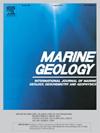过去21 ka海平面变化和印度夏季风对尼尼特酵母脊化学风化和沉积的影响
IF 2.2
3区 地球科学
Q2 GEOSCIENCES, MULTIDISCIPLINARY
引用次数: 0
摘要
从Ninetyeast Ridge (NER)获取的沉积物岩心为海洋环境中化学风化过程与沉积物沉积模式之间的相互作用提供了有价值的见解。这种相互作用受到海平面波动和印度夏季风(ISM)变化的强烈影响。在这项研究中,元素组成的地球化学分析表明,末次盛冰期(~ 21-19 ka)是一个化学风化作用增强的时期,可能是由海平面下降和冰川或风成活动加剧引起的。同时,在沉积记录中,高地表生产力和低底水氧合作用有利于有机碳的聚集。而去冰期(~ 17-11 ka)则以海平面快速上升和季风动态演化为特征。除Bølling - allero ød (B/A)层段外,该层段普遍表现为含氧底水条件。在B/A事件期间,沉积速率的增加与古生产力的提高和海洋缺氧条件相一致。全新世反映了一种转变,海平面上升和ISM活动加剧促进了源区化学风化的增强。值得注意的是,全新世气候最佳期(HCO)是一个太阳日照增加和印度洋-太平洋暖池内季风环流增强的时期,这一时期有助于海底脱氧和海洋生产力的提高。这些发现强调了海平面波动和季风强迫之间复杂的耦合,从而调节了印度洋盆地的化学风化机制和深海沉积动力学。本文章由计算机程序翻译,如有差异,请以英文原文为准。
Sea level changes and the Indian Summer Monsoon influence on chemical weathering and sediment deposition on the Ninetyeast Ridge over the past 21 ka
The sediment core retrieved from the Ninetyeast Ridge (NER) provides valuable insights into the interplay between chemical weathering processes and sediment deposition patterns in the marine environment. This interplay is strongly influenced by fluctuations in sea level and variations in the Indian Summer Monsoon (ISM). In this study, geochemical analyses of elemental compositions suggest that the Last Glacial Maximum (LGM) (∼21–19 ka) was a period of enhanced chemical weathering, likely driven by lowered sea levels and intensified glacial or aeolian activity. Concurrently, high surface productivity and reduction in bottom-water oxygenation favored the accumulation of organic carbon in the sedimentary record. In contrast, the deglacial period (∼17–11 ka) was characterized by rapid sea-level rise and dynamic monsoon evolution. This interval generally exhibited oxic bottom-water conditions, except for the Bølling–Allerød (B/A) interstadial. During the B/A event, increased sedimentation rates coincided with elevated paleoproductivity and suboxic marine conditions. The Holocene epoch reflects a shift, as rising sea levels and intensified ISM activity promoted enhanced chemical weathering in source regions. Notably, the Holocene Climatic Optimum (HCO) stands out as a period when increased solar insolation and strengthened monsoon circulation within the Indo-Pacific Warm Pool contributed to bottom-water deoxygenation and increased marine productivity. These findings highlight the intricate coupling between sea-level fluctuations and monsoonal forcing in modulating chemical weathering regimes and deep-sea sedimentation dynamics in the Indian Ocean basin.
求助全文
通过发布文献求助,成功后即可免费获取论文全文。
去求助
来源期刊

Marine Geology
地学-地球科学综合
CiteScore
6.10
自引率
6.90%
发文量
175
审稿时长
21.9 weeks
期刊介绍:
Marine Geology is the premier international journal on marine geological processes in the broadest sense. We seek papers that are comprehensive, interdisciplinary and synthetic that will be lasting contributions to the field. Although most papers are based on regional studies, they must demonstrate new findings of international significance. We accept papers on subjects as diverse as seafloor hydrothermal systems, beach dynamics, early diagenesis, microbiological studies in sediments, palaeoclimate studies and geophysical studies of the seabed. We encourage papers that address emerging new fields, for example the influence of anthropogenic processes on coastal/marine geology and coastal/marine geoarchaeology. We insist that the papers are concerned with the marine realm and that they deal with geology: with rocks, sediments, and physical and chemical processes affecting them. Papers should address scientific hypotheses: highly descriptive data compilations or papers that deal only with marine management and risk assessment should be submitted to other journals. Papers on laboratory or modelling studies must demonstrate direct relevance to marine processes or deposits. The primary criteria for acceptance of papers is that the science is of high quality, novel, significant, and of broad international interest.
 求助内容:
求助内容: 应助结果提醒方式:
应助结果提醒方式:


